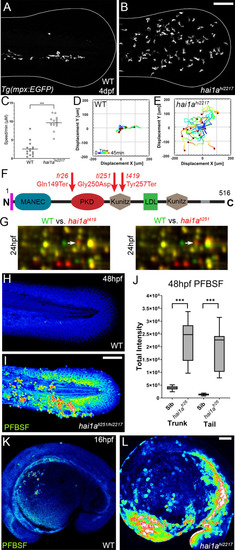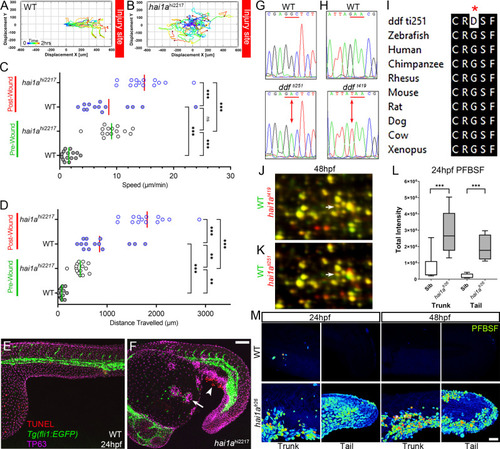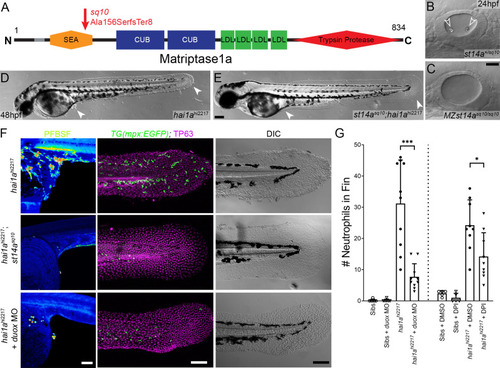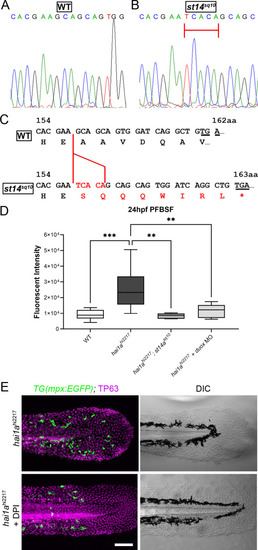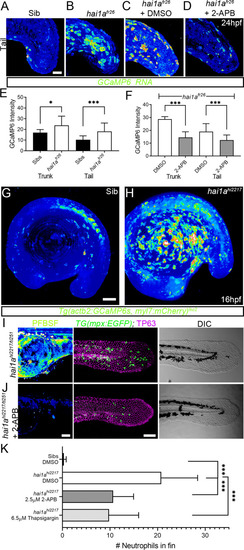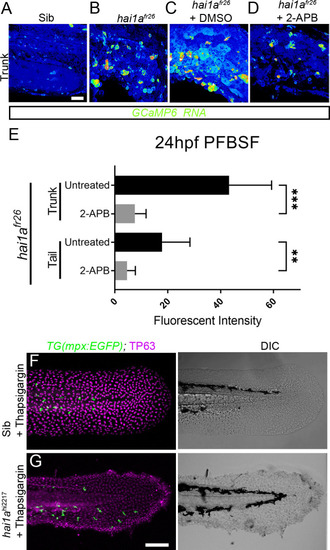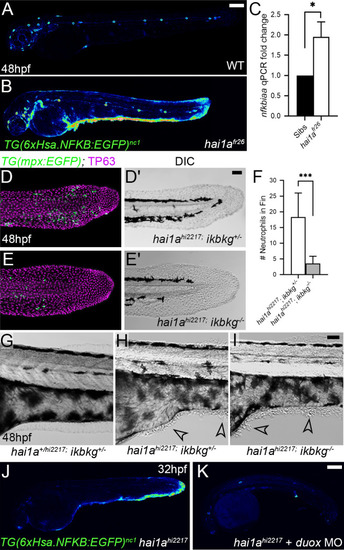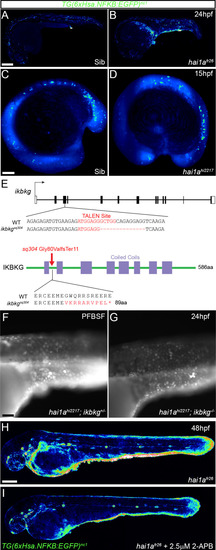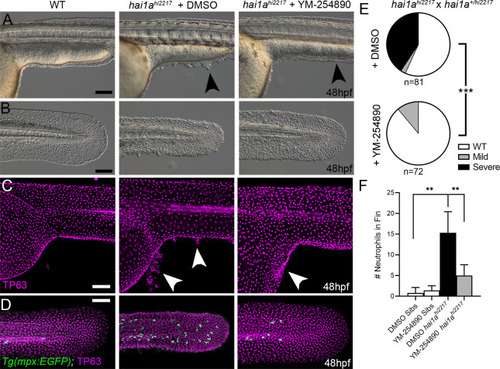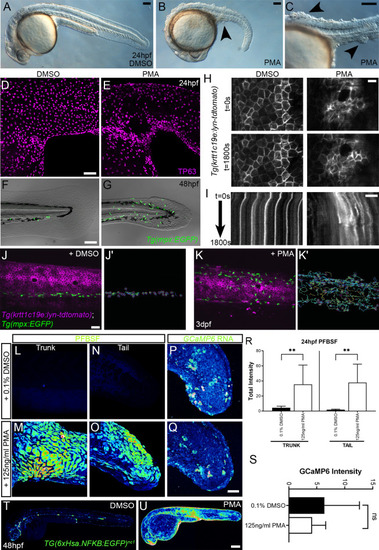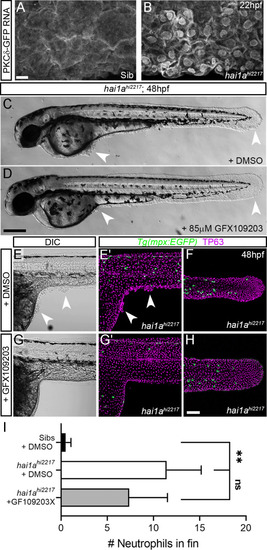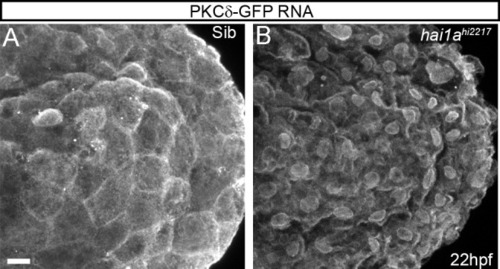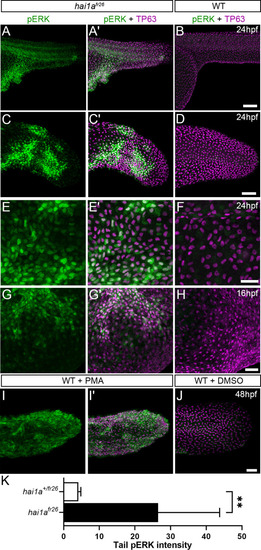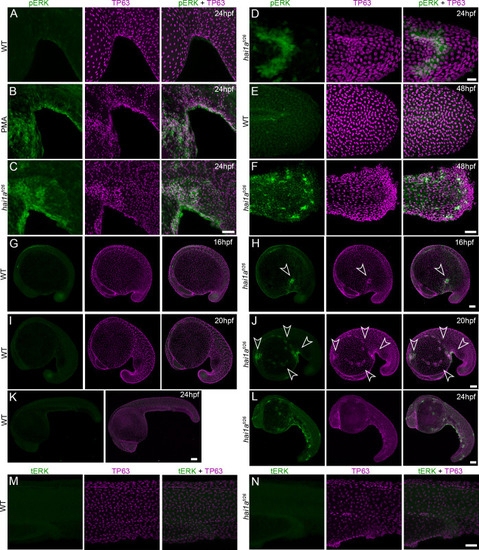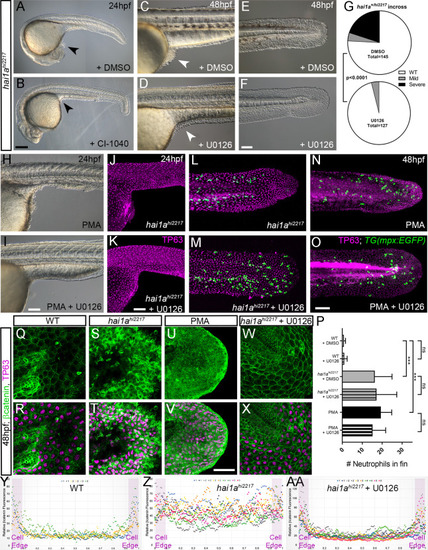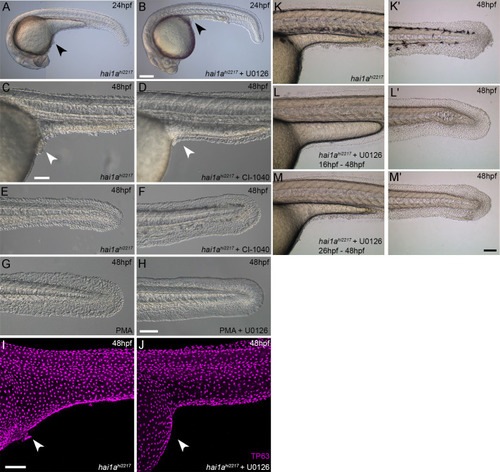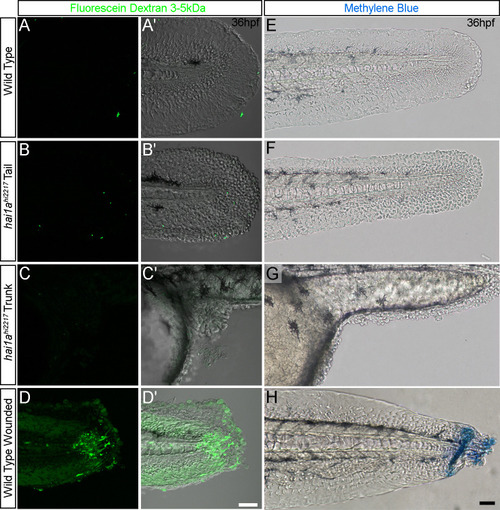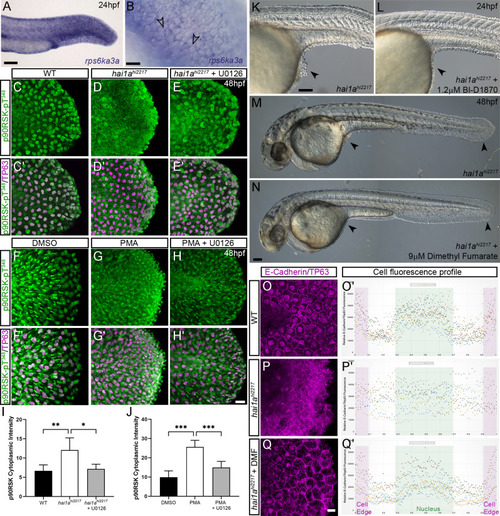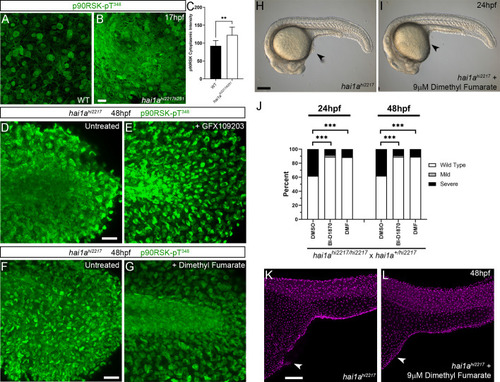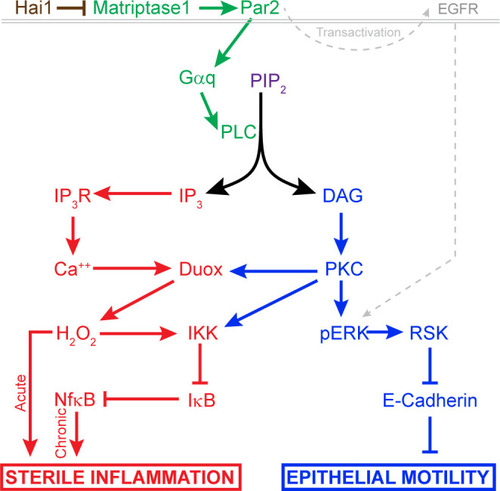- Title
-
Matriptase activation of Gq drives epithelial disruption and inflammation via RSK and DUOX
- Authors
- Ma, J., Scott, C.A., Ho, Y.N., Mahabaleshwar, H., Marsay, K.S., Zhang, C., Teow, C.K., Ng, S.S., Zhang, W., Tergaonkar, V., Partridge, L.J., Roy, S., Amaya, E., Carney, T.J.
- Source
- Full text @ Elife
|
(A, B) Projected confocal images showing neutrophils populate the tail of hai1ahi2217 mutants (B) but just the vasculature of WT (A) at 4dpf labelled by the Tg(mpx:EGFP)i114 line. Fin extremity outlined in white. (C) Neutrophils move significantly faster in hai1ahi2217 than WT. n = 15; t-test; ***p<0.001. (D, E) Tracks of neutrophil migration taken from Video 1 in WT (D) and hai1ahi2217 (E). (F) Schematic of the Hai1a protein with protein domains given, signal peptide as purple line and transmembrane domain as grey line. Location and nature of the fr26 and two dandruff alleles, ti251 and t419 given. (G) Selected region of 2D gel of protein extracted from 24hpf embryos for hai1at419 (left) or hai1ati251 (right) in red, superimposed over WT protein samples (green in both). The shift in pI of peroxiredoxin4 in both alleles is indicated with an arrow. (H, I) Projected lateral confocal views of pentafluorobenzenesulfonyl fluorescein (PFBSF) staining of WT (H) and hai1ati251/hi2217 (I) tail fins at 48hpf. (J) Box and whiskers plot of PFBSF fluorescent staining intensity of WT and hai1afr26 mutants at 48hpf in trunk and tail. n = 9; t-test ***p<0.001. (K, L) Projected lateral confocal views of PFBSF staining of WT (K) and hai1ahi2217 (L) at 16hpf. Scale bars: (B, I, L) = 100 �m. |
|
(A, B) Tracks of neutrophil migration taken from Video 2 in WT (A) and hai1ahi2217 (B) from immediately after wounding tail fin at indicated site. (C, D) Graph of neutrophil speed (C) and distance travelled (D) before and after wounding in WT and hai1ahi2217. Neutrophils in wounded WT move as fast as unwounded hai1a mutants. Wounding hai1a mutants accelerates neutrophils. n = 15; ANOVA with Bonferroni post-test ***p<0.001, **p<0.01. (E, F) Projected confocal images showing neutrophils (green, labelled by Tg(fli1:egfp)y1 transgenic line) are not attracted to regions of apoptosis (arrowhead, red, stained by TUNEL), but to epidermal aggregates (arrow, magenta, stained by anti-TP63) in 24hpf hai1ahi2217 mutants (F) but not WT (E). (G, H) Sequence chromatograms of genomic DNA from WT (upper panels) and dandruff alleles ti251 (G) and t419 (H) (lower panels). Altered codon is underlined in red with altered base indicated by arrow. (I) ClustalW protein alignment of the amino acid substitution in the ti251 allele showing broad conservation of across vertebrates. (J, K) Selected regions of 2D gel of protein extracted from 48hpf embryos for hai1at419 (J) or hai1ati251 (K) in red, superimposed over WT protein samples (green in both). The shift in pI of Peroxiredoxin4 in both alleles is indicated with an arrow. (L) Box and whiskers plot of pentafluorobenzenesulfonyl fluorescein (PFBSF) fluorescent staining intensity of WT and hai1afr26 mutants at 24hpf in trunk and tail. n = 9; t-test ***p<0.001. (M) Lateral projected confocal views of PFBSF staining of WT (upper row) and hai1afr26 (lower row) trunks and tails at 24hpf and 48hpf. Scale bars (F) = 100 �m; (M) = 50 �m. |
|
(A) Schematic of the Matriptase1a protein with domains given and transmembrane domain as grey line. Location and nature of the sq10 allele given by red arrow. (B, C) Lateral DIC (Differential Interference Contrast) images of st14a+/sq10 (B) and MZ st14asq10 (C) otic vesicles at 24hpf showing absence of otoliths (arrowheads in B) in the maternal zygotic st14a mutants. (D, E) Lateral DIC images of hai1ahi2217 single mutant (D) and st14asq10; hai1ah12217 double mutant (E) at 48hpf highlighting rescue of epidermal aggregates and fin morphology (arrowheads) in the double mutants. (F) Projected confocal images of pentafluorobenzenesulfonyl fluorescein (PFBSF) staining at 24hpf (left column), TP63 (magenta), and eGFP (green) antibody staining at 48hpf (middle column) with DIC imaging (right column) for hai1ahi2217 single mutants (top row), st14asq10; hai1ahi2217 double mutants (middle row), and hai1ahi2217 mutants injected with 0.4 mM, duox MO + 0.2 mM tp53 morpholino (bottom row). Individuals for middle and right columns were hemizygous for the Tg(mpx:eGFP)i114 transgene. (G) Counts of eGFP-positive neutrophils on the fins of hai1ahi2217; Tg(mpx:eGFP)i114 or Tg(mpx:eGFP)i114, and either uninjected, injected with morpholino against duox (left side of graph), treated with 0.5% DMSO (Dimethyl sulfoxide) or 40 �M diphenyleneiodonium (DPI) (right side of graph). n = 10; t-test; ***p<0.001; *p<0.05. Scale bars: (C) = 20 �m; (E, F) = 100 �m. |
|
(A, B) Sequence chromatograms of part of exon 6 of the zebrafish st14a gene from WT (A) and the st14asq10 allele showing the 5 bp insertion highlighted by red bar. (C) Effect of the 5 bp insertion (red) in the sq10 allele leads to alteration of reading frame, eight aberrant amino acids followed by a termination codon (red lettering). The codon altered to nonsense codon is underlined in both WT and mutant sequences. (D) Box and whiskers plot of pentafluorobenzenesulfonyl fluorescein (PFBSF) fluorescent staining intensity of 24hpf WT, hai1ahi2217 mutants, hai1ah12217; st14asq10 double mutants, and hai1ahi2217 injected with duox MO. n = 8; ANOVA with Bonferroni post-test ***p<0.001, **p<0.01. (E) TP63 (magenta) and eGFP (green) antibody staining (left column) with DIC imaging (right column) for 48hpf hai1ahi2217; Tg(mpx:eGFP)i114 mutants either untreated (top row) or treated with 40 �M diphenyleneiodonium (DPI) (bottom row). Scale bar: (D) = 100 �m. |
|
(A?D) Projected confocal images of eGFP in the tail of WT (A) or hai1afr26; (B?D) injected with GCaMP6s RNA, imaged at 24hpf, indicating calcium dynamics. Embryos are either untreated (A, B), treated with DMSO (C), or with 2.5 �M 2-APB (D). Images are temporal projections of timelapse movies taken at maximum speed intervals (2 min) and projected by time. (E, F) Graphs comparing eGFP intensities from GCaMP6s RNA timelapses in trunk and tail between 24hpf WT and hai1afr26 (E) and between hai1afr26 treated with DMSO and 2.5 �M 2-APB (F). n = 10; t-test; *p<0.05, ***p<0.001. (G, H) Projected light-sheet images of Tg(actb2:GCaMP6s, myl7:mCherry)lkc2 embryos indicating calcium dynamics at 16hpf of sibling (G) or hai1ahi2217 (H). Images are temporal projections of timelapse movies taken at 45 s intervals and projected by time. (I, J) Pentafluorobenzenesulfonyl fluorescein (PFBSF) staining at 24hpf (left column), TP63 (magenta), and eGFP (green) antibody staining at 48hpf (middle column) with DIC imaging (right column) for hai1ahi2217/ti251 mutants (J), or hai1ahi2217/ti247 mutants treated with 2.5 �M 2-APB (I). Individuals for middle and right columns were hemizygous for the Tg(mpx:eGFP)i114 transgene. (K) Counts of eGFP-positive neutrophils in the fins at 48hpf of Tg(mpx:eGFP)i114, or hai1ahi2217; Tg(mpx:eGFP)i114 treated with 0.5% DMSO, 2.5 �M 2-APB, or 6.5 �M thapsigargin. n = 20; t-test; ***p<0.001. Scale bars (A?D) = 50 �m; (G, I, J) = 100 �m. |
|
(A?D) Projected confocal images of eGFP in the trunk of WT (A) or hai1afr26; (B?D) injected with GCaMP6s RNA, imaged at 24hpf, indicating calcium dynamics. Embryos are either untreated (A, B), treated with DMSO (C), or with 2.5 �M 2-APB (D). Images are temporal projections of timelapse movies taken at maximum speed intervals (3 min) and projected by time. (E) Plot of pentafluorobenzenesulfonyl fluorescein (PFBSF) fluorescent staining intensity of hai1afr26 mutants at 24hpf in trunk and tail, either untreated or treated with 2-APB. n = 14; ANOVA with Bonferroni post-test ***p<0.001, **p<0.01. (F, G) Projected confocal images of tail fins of 48hpf larvae immunostained with TP63 (magenta) and eGFP (green) (left column) with DIC imaging (right column). Larvae were both hemizygous for Tg(mpx:eGFP)i114 transgene and were treated with 6.5 �M thapsigargin. Genotypes are hai1a+/hi2217 sibling (F) and hai1ahi2217 mutant (G). Rescue of neutrophil inflammation, but not epidermal defect, is apparent in treated hai1a mutant. Scale bars: (A) = 50 �m; (G) = 100 �m. |
|
(A, B) Lateral confocal projections of Tg(6xHsa.NFKB:EGFP)nc1 embryos reporting NfkB signalling levels at 48hpf for WT (A) and hai1afr26 (B). (C) qPCR of cDNA levels of NfkB target gene nfkbiaa in hai1afr26 vs. sibs at 48hpf. n = 3, 200 embryos pooled in each, t-test *p<0.05. (D?E?) Projected confocal images of the tail fins of 48hpf Tg(mpx:eGFP)i114; hai1ahi2217 embryos, immunostained for TP63 (magenta) and eGFP (green) (D, E) with corresponding DIC image (D?, E?). Embryos were either mutant for ikbkg (ikbkgsq304, E?E?) or heterozygous (ikbkg+/sq304; D?D?). (F) Counts of eGFP-positive neutrophils in the fins at 48hpf of hai1ahi2217; ikbkg+/sq304 and hai1ahi2217; ikbkgsq304. Embryos were hemizygous for Tg(mpx:eGFP)i114. n = 9; t-test; ***p<0.001. (G?I) Lateral DIC images of the trunk of hai1a+/hi2217; ikbkg+/sq304 (G), hai1ahi2217; ikbkg+/sq304 (H), and hai1ahi2217; ikbkgsq304 (I). Loss of IKBKG does not rescue epidermal defects of hai1a mutants (arrowheads). (J, K) Lateral confocal projections of Tg(6xHsa.NFKB:EGFP)nc1 embryos reporting NfkB signalling levels at 32hpf of hai1ahi2217 uninjected (J) or injected with duox MO (K). Loss of H2O2 reduces NfkB signalling levels in hai1a mutants. Scale bars: (A, K) = 200 �m; (D?, I) = 50 �m. |
|
(A?D) Lateral confocal projections of Tg(6xHsa.NFKB:EGFP)nc1 embryos reporting NfkB signalling levels of hai1afr26 at 24hpf (B), hai1ahi2217 at 15hpf, and siblings at 24hpf (A) and 15hpf (C). The increase in NfkB reporter signal occurs after overt phenotype onset. (E) Nature of the ikbkgsq304 mutant allele showing TALEN site location within the intron-exon structure of the gene (coding and non-coding exons depicted as filled and open boxes, respectively). Sequence of part of exon 3 shown below with the TALEN binding site in red. The 14 bp deletion in the ikbkgsq304 allele is indicated under the WT sequence as dashes. This leads to a frameshift changing codon 80 from GGC (Gly) to GGT (Val), then nine aberrant amino acids followed by a stop codon. (F, G) Lateral widefield fluorescent images of hai1ahi2217; ikbkg+/sq304 (F) and hai1ahi2217; ikbkgsq304 (G) embryos at 24hpf stained with pentafluorobenzenesulfonyl fluorescein (PFBSF) showing no loss of H2O2 in hai1a mutants upon mutation of ikbkg. (H, I) Lateral confocal projections of 48hpf hai1afr26; Tg(6xHsa.NFKB:EGFP)nc1 embryos, treated with DMSO (H) or with 2.5 �M 2-APB (I). Scale bars: (A, H) = 200 �m; (C) = 100 �m; (F) = 50 �m. |
|
(A?D) Lateral images of ventral trunk and tail at 48hpf for WT (left panels), hai1ahi2217 treated with 0.5% DMSO (middle panels), and hai1ahi2217 treated with 32 �M YM-254890 (right panels). DIC micrographs are shown in (A, B), whilst projected confocal images are shown in (C, D), where embryos are immunostained for TP63 (C, D; magenta) and eGFP (D; green). Embryos in (D) are hemizygous for Tg(mpx:eGFP)i114. Arrowheads indicate region of aggregate formation lost upon treatment with Gq inhibitor YM-254890. (E) Pie charts showing proportion of embryos with no (WT; white), mild (grey) or severe (black) hai1a mutant epidermal phenotypes. Embryos were derived from hai1ahi2217/hi2217 � hai1a+/hi2217 crosses and assayed at 48hpf. Clutches treated with 0.5% DMSO (upper pie chart) were compared to those treated with 32 �M YM-254890 (lower pie chart) by Chi-squared analysis. ***p<0.001; n = 72. (F) Graph of counts of eGFP-positive neutrophils in the fins at 48hpf of Tg(mpx:eGFP)i114, or hai1ahi2217; Tg(mpx:eGFP)i114 treated with 0.5% DMSO, or 32 �M YM-254890. n = 6; Mann?Whitney test; **p<0.01. Scale bars: (A?D) = 100 �m. |
|
( |
|
(A, B) Confocal images of the ventral fin of 22hpf sibling (A) or hai1ahi2217 (B) embryos injected with RNA encoding PKC?-GFP. Mostly cytoplasmic distribution in sibling was relocated to cell and nuclear membranes in hai1a mutants. (C, D) Lateral brightfield images of 48hpf hai1ahi2217 larvae treated with 0.5% DMSO (C) or 85 �M GFX109203 (D). Epidermal aggregates and fin deterioration are rescued by the PKC inhibitor (arrowheads). (E?H) DIC (E, G) and projected confocal images (E?, G?, F, H) of hai1ahi2217; Tg(mpx:eGFP)i114 trunk at 24hpf (E?E?, G?G?) and tail at 48hpf (F, H), either treated with 0.5% DMSO (E?F) or 85 �M GFX109203 (G?H). Embryos are immunostained for TP63 (magenta) and eGFP (green), highlighting rescue of epidermal phenotype and partial rescue of neutrophils by GFX109203. (I) Counts of eGFP-positive neutrophils in the fins at 48hpf of Tg(mpx:eGFP)i114, or hai1ahi2217; Tg(mpx:eGFP)i114 treated with 0.5% DMSO or 85 �M GFX109203. n = 8; ANOVA, Dunn?s multiple comparisons; **p<0.01. Scale bars: (A) = 10 �m; (D) = 200 �m; (H) = 100 �m. |
|
( |
|
(A?L) Lateral projected confocal images of trunks (A, A?, B, E, E?, F), yolk surface (G, G?, H) and tails (C, C?, D, I, I?, J) of embryos immunostained for TP63 (A?, B, C?, D, E?, F, G?, H, I?, J; magenta) and pERK (A, J; green) at 24hpf (A?F), 16hpf (G?H), and 48hpf (I?J). Both hai1afr26 (A, A?, C, C?, E, E?, G, G?) and 125 ng/ml PMA-treated (I, I?) embryos show increased epidermal pERK levels compared to untreated WT (B, D, F, H, J). Elevation of epidermal pERK in hai1afr26 mutants and PMA- treated embryos is seen in the trunk (A, E) and tail (C, I) as well as in epidermis over the yolk prior to overt phenotype manifestation (G). (K) Quantification of pERK immunofluorescent intensity in the tail of 24hpf hai1afr26 larvae compared to siblings. n = 5; Mann?Whitney test; **p<0.01. Scale bars: (B) = 100 �m; (D, H, J) = 50 �m; (F) = 20 �m. |
|
( |
|
(A?F) Lateral DIC images of 24hpf (A, B) or 48hpf (C?F) hai1ahi2217 embryos treated with either DMSO (A, C, E), 1.3 �M CI-1040 (B), or 100 �M U0126 (D, F) showing rescue of general morphology (B), trunk (D), and tail (F) epidermal phenotypes compared to DMSO-treated hai1ahi2217. Epidermal aggregates under the yolk are reduced in the treated mutants (A?D; arrowheads). (G) Proportion of 48hpf larvae derived from hai1a+/hi2217 incross showing mild or severe hai1a epidermal phenotype following DMSO (upper) or U0126 (lower) treatment (Chi-squared test). (H, I) Lateral DIC images of 24hpf embryo treated with 125 ng/ml phorbol 12-myristate 13-acetate (PMA) (H) or PMA and U0126 (I). Yolk-associated epidermal aggregates are reduced. (J?M) Lateral projected confocal images of hai1ahi2217; Tg(mpx:eGFP)i114 trunk at 24hpf (J, K) and tail at 48hpf (L, M), either treated with 0.5% DMSO (J, L) or U0126 (K, M). Embryos are immunostained for TP63 (magenta) and eGFP (green), highlighting rescue of epidermal phenotype but no reduction of neutrophils. (N, O) Lateral projected confocal images of Tg(mpx:eGFP)i114 treated with PMA alone (N) or PMA with U0126 (O) and immunostained for TP63 (magenta) and eGFP (green). Fin morphology is restored but neutrophils are still present. (P) Quantification of neutrophils in the fins showing U0126 does not reduce inflammation induced by loss of hai1a or PMA treatment. n = 8; ANOVA with Bonferroni post-test; ***p<0.001. (Q?X) Projected confocal images of 48hpf larval tails immunostained for ?-catenin (green) and TP63 (magenta; R, T, V, X) of WT (Q, R, U, V) and hai1ahi2217 (S, T, W, X), either untreated (Q?T), treated with PMA (U, V) or U0126 (W, X). (Y?AA) Profile plots of fluorescence distribution across cells of WT (Y), hai1ahi2217 (Z), and hai1ahi2217 treated with U0126 (AA). X-axis represents width of the cell. ?-catenin immunofluorescence intensity (Y-axis) shows majority at cell edge (demarcated in light purple) in WT and rescued hai11a mutants, but is distributed in cytoplasm in mutant. Two cells per 3?5 larvae were analysed. Scale bars: (B) = 200 �m, (F, I, K, O) = 100 �m, (V) = 20 �m. |
|
( |
|
( |
|
(A, B) In situ hybridisation of rps6ka3a at 24hpf under low- (A) and high-power (B) magnification showing expression in basal keratinocytes. Open arrowheads in (B) indicate borders of EVL cells bisecting nuclei of underlying rps6ka3a-positive cells. (C?H?) Lateral projected confocal images of the tails of embryos immunostained for p90RSK (Phospho-Thr348) (C?H?) and TP63 (C??H?). In both the hai1ahi2217 (D, D?) and 125 ng/ml phorbol 12-myristate 13-acetate (PMA)-treated (G, G?) embryos, there is an increase in cytoplasmic levels of p90RSK (Phospho-Thr348) signal above the nuclear only signal seen in WT (C, C?) or DMSO (F, F?). Treatment with the pERK inhibitor U0126 reduced cytoplasmic levels but did not affect nuclear signal (E, E?; H, H?), (I, J) Quantification of immunofluorescent intensity of cytoplasmic levels of p90RSK (Phospho-Thr348) in basal keratinocytes of tails of 48hpf WT and hai1ahi2217, treated with DMSO or U0126 (I), and PMA or PMA plus U0126 (J). Nucleus signal was excluded by masking from the DAPI channel. n = 5; t-test; ***p<0.001, **p<0.01, *p<0.05. (K?N) Lateral DIC images of hai1ahi2217 embryos at 24hpf (K, L) and 48hpf (M, N) untreated (K, M) or treated with 1.2 �M BI-D1870 (L) or 9 �M dimethyl fumarate (DMF). Locations of epidermal aggregates and loss of tail fin morphology in hai1a mutants, and their rescue by RSK inhibitor treatment are indicated by arrowheads. (O?Q) Lateral projected confocal images of the tails of embryos immunostained with antibodies against E-cadherin and TP63in WT (O, P) and hai1ahi2217 treated with DMF (Q). (O??Q?) Profile plots of fluorescence distribution across cells of WT (O), hai1ahi2217 (P?), and hai1ahi2217 treated with DMF (Q?). X-axis represents width of the cell. ?-Catenin immunofluorescence intensity (Y-axis) shows majority at cell edge (E-cadherin domain demarcated in light purple) and centre of cell (nucleus demarcated in light green) in WT and rescued hai11a mutants, but there is no clear membrane signal in the untreated hai1a mutants. Two cells per five larvae were analysed. Scale bars: (A, K, N) = 100 �M; (B, H) p=20 �M. |
|
( |
|
Proposed model of pathways downstream of Hai1 which drives chronic and acute sterile inflammation (red) and epithelial motility (blue). A previously defined transactivation of EGFR is also integrated. Other pathways known to act downstream of Matriptase, involving cMet, PI3K, AKT, and mTOR, are not shown. |

